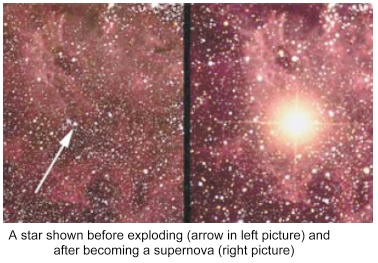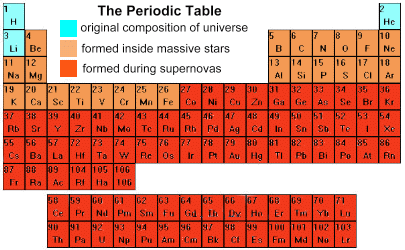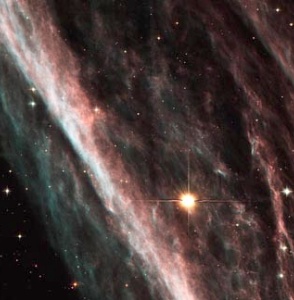 A supernova is an explosion of a massive star. The word 'nova', meaning 'new' in Latin, was used to refer to newly appearing bright stars in the sky. Super novas are much rarer; on average, a supernova occurs about once every 50 years in a galaxy the size of our own Milky Way. The earliest recorded supernova was viewed by Chinese astronomers in AD 185.  The light from a single star exploding as a supernova can outshine the hundreds of billions of stars in the galaxy that contains it, before fading out over the course of a few weeks or months.
The light from a single star exploding as a supernova can outshine the hundreds of billions of stars in the galaxy that contains it, before fading out over the course of a few weeks or months. Supernova explosions enrich interstellar regions with heavy elements. In addition, the expanding shock waves from a supernova can cause the formation of new stars. On this page we'll explain how supernovas are created, and describe the effects they have on the space around them.  A supernova happens when an old star has used up most of its nuclear fuel, and collapses upon itself in less than a
second. A shock wave is propelled outwards from the center of the collapsing star, causing the outer layers to be blown away at speeds that are a significant fraction of the speed of light.
A supernova happens when an old star has used up most of its nuclear fuel, and collapses upon itself in less than a
second. A shock wave is propelled outwards from the center of the collapsing star, causing the outer layers to be blown away at speeds that are a significant fraction of the speed of light.A supernova can radiate as much energy in a very short time as the Sun would emit over 10 billion years. The shock wave can be seen as an expanding shell of gas and dust called a supernova remnant. At the same time, the shock wave compresses what's left of the core of the star, raising it to enormous temperature and density. This can cause the formation of a neutron star or black hole at the center. Let's look at what happens to a massive star near the end of its life. There are various models that describe how a supernova can happen; we'll outline the formation of a Type II supernova, which is the most straightforward. Stars 'burn' because they are so massive. An immense cloud of hydrogen gas collects and is drawn together by its own gravity. As the ball of gas increases in mass, the outer layers press down on the inner ones, raising the temperature and density . Eventually the temperature at the core becomes so high that individual hydrogen nuclei are forced together, or 'fused', to form helium nuclei. This process is called nuclear fusion. When a helium nucleus is formed from two hydrogen nuclei, there is left-over energy, which is released. This process is called nuclear fusion, and it's what powers stars; the excess energy from the huge number of nuclei undergoing fusion escapes as light and other forms of energy. In a normal-size star like our Sun, this process is stable over billions of years. The outward pressure of the energy now being released at the core balances the gravitational force that was causing the ball of gas to contract, and the star stops contracting. It continues to radiate energy; this equilibrium will continue as long as there is sufficient hydrogen to fuse and release energy. It's what happens when the star starts to run out of hydrogen fuel that makes things interesting. For a star that's similar to our Sun in mass, the end, after about 10 billion years, is not that spectacular. As less and less hydrogen becomes available to support fusion, the radiated energy begins to decline. The star then starts to contract again under its own weight. As the relatively cooler outer layers fall down onto the much hotter core, they explode, causing the surface of the star to balloon outwards. The star expands dramatically in size (in the case of our Sun, perhaps out past the orbit of Mars), releasing a great amount of energy as it does so. These exploding stars can be seen from great distances, and are called novas. Depending on the mass of the original star, the pressure of the explosion may compress the core into a white dwarf; a tiny Earth-sized star that will continue to radiate energy for billions of years as it gradually cools off. Other than frying the surfaces of its innermost planets and becoming much brighter for a while, a nova doesn't have much effect upon the stars surrounding it. Since stars like our Sun are quite common, novas are a fairly commonly observed occurrence in our galaxy and others. Supernovas When a star is more than nine times as massive as our Sun, something quite different and more spectacular happens when it begins to run out of fuel. First of all, stars that are this massive burn a lot hotter than our Sun, and go through their hydrogen gas a lot quicker. Where a star like our Sun can continue burning for 10 billion years (it's been doing that for 5 billion years so far), a much more massive star might run through all of its fuel in a mere million years (one ten-thousanth of our Sun's lifetime). In a massive star, when the core's supply of hydrogen is exhausted, the outward radiation pressure starts to drop and the core begins to collapse. In this case, however, the rise in temperature and pressure is large enough to cause the helium that has been produced to begin fusing also. Helium nuclei combine to form carbon nuclei. The radiation released from this new fusion reaction is enough to stop the collapse of the star. As helium fusion now takes place in the core, hydrogen fusion continues to happen in a shell of gas just outside the core.  The helium fusion reaction in the core rapidly exhausts the supply of helium. Depending on how massive the star is, the whole cycle can begin again, with the core collapsing and raising the temperature so that a new reaction can start by combining carbon nuclei. Now there are three shells of gas; the innermost core is burning carbon, while outside of that are shells burning helium and hydrogen.
The helium fusion reaction in the core rapidly exhausts the supply of helium. Depending on how massive the star is, the whole cycle can begin again, with the core collapsing and raising the temperature so that a new reaction can start by combining carbon nuclei. Now there are three shells of gas; the innermost core is burning carbon, while outside of that are shells burning helium and hydrogen. This process can occur over and over again, each time involving more massive nuclei and higher temperatures and pressures. In addition, each new fusion process proceeds much more rapidly than the previous one. The final burn, producing iron, consumes its fuel in about 24 hours. At this point the massive star is layered like an onion, with the fusing of many different elements occurring in larger and larger shells from the core outwards. Now things begin to heat up ... and they happen very quickly. No further new fusion reactions after iron can begin, since the new nuclei created would require energy, rather than releasing it. As the innermost core runs out of fuel for the last time, the radiation decreases and the shells above begin to collapse into the core. The star collapses with velocities as high as 70,000 kilometres per second, or about a quarter of the speed of light. This raises the inner core's temperature to somewhere near 100 billion degrees. The density of the core also increases dramatically. The density becomes so high that the heavy nuclei produced by the final burn break back down into helium and a flood of neutrons, while electrons and protons are forced together to form more neutrons and neutrinos. Much energy (about 10% of the star's mass) is carried away by the neutrinos over a period of about 10 seconds, leaving behind a stable core that is a solid mass of neutrons. The massive amounts of energy carried outward from the core by these neutrinos cause the outer layers of the star to explode. This is no 'ordinary' nova explosion; so much energy is released by the star in such a short period of time that the star can outshine all the billions of stars in its galaxy, and eventually be visible many millions of light years away. The massive amounts of energy released by the explosion can also cause many of the nuclei that were formed inside the star to combine with each other, creating all of the elements above iron in the periodic table. In short, a massive star, which may have begun life as a ball of hydrogen and helium, ends up producing all of the other elements in the periodic table ... the ones up to iron by nuclear fusion as the star burns, and the ones after iron when it explodes. [Recent research has suggested that elements heavier than iron may in fact have been made when two neutron stars in a binary star system collide]. The inner core, having been compressed by the explosion, with all its nuclei forced together into a mass of neutrons, will now be about 30 kilometres in diameter, and extremely dense. After the outer layers have been blown away, this is all that is left of the giant star. It is called a neutron star, and it is the end result of the explosion of a star whose mass was between 9 and 20 times the mass of our Sun. If a star is more than 20 times as massive as our Sun, it will also explode as a supernova, but in this case the heat and pressure of the explosion are large enough to cause the core to be compressed to such a high degree that it becomes a black hole. When a supernova occurs, all the elements that have been formed inside the star in its relatively short lifetime are expelled violently into the surrounding interstellar medium as a rapidly expanding shock wave of material. This expelled material mixes with the hydrogen, helium, and other gases and dust that are already present there. The universe is thought to be about 15 billion years old. Originally it was mostly all hydrogen and helium, and perhaps some lithium, which began coalescing into galaxies of stars because of gravitational forces. However, after the first few billion years, many generations of short-lived massive stars, having exploded as supernovas, began to enrich this gas with all of the heavier elements. These elements enrich the gas clouds that are the sites of new star formation. Later generations of stars, including our Sun and its planets, formed from this enriched material. Every element on Earth heavier than hydrogen and helium was once 'cooked' in a massive star that became a supernova.  Evidence shows that a nearby supernova helped determine the composition of the Solar System 5 billion years ago, and may even have triggered the formation of our system.
What effect would the explosion of a Type II supernova nearby have on Earth? The supernova would have to occur within a few hundred light years of us for there to be a noticeable effect. (The nearest star is about 4.3 light years away). Gamma radiation from a nearby exploding star, if it was less than 30 light years away, could deplete the ozone layer in Earth's upper atmosphere enough to expose the surface to harmful solar and cosmic radiation. Fortunately, supernovas that close are statistically only likely to occur every hundred million years or so. (A gamma ray burst from a nearby supernova explosion has in fact been proposed as the cause of the Ordovician extinction, which resulted in the death of nearly 60% of the oceanic life on Earth). There are several stars within a few hundred light years from the Sun that are likely are candidates for becoming supernovae in as little as a thousand years. One example is Betelgeuse, a red supergiant 427 light-years from Earth; however, it is a little too far away to be much of a threat.
|


